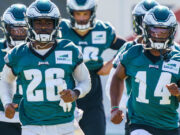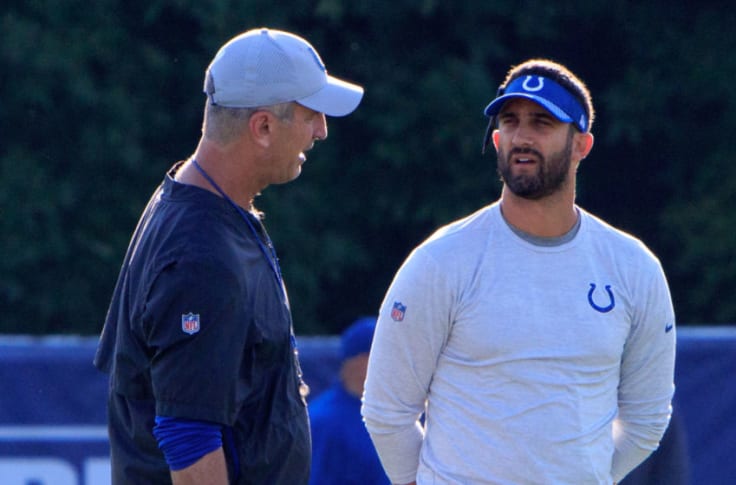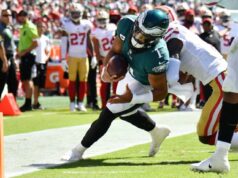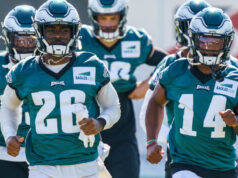The Philadelphia Eagles finalized and announced the hiring of Nick Sirianni as their new head coach this past Sunday, January 24. The former Indianapolis Colts offensive coordinator has been lauded by Frank Reich and others around the league, citing his fiery leadership and experience coaching the quarterbacks and wide receiver positions. The belief is that his approach to the offense will help numerous players on the Eagles’ roster in ways that the previous regime under Doug Pederson couldn’t.
The big question that many are asking is how exactly Sirianni is going to make that happen. He didn’t call plays for the Colts’ offense, so how much of their offense’s success did he contribute to? Also, if he plans on taking inspiration from what Frank Reich has taught him in both the San Diego Chargers and Colts organizations, what do those philosophies and concepts look like?
If we are under the assumption that Sirianni will be incorporating a lot of what the Colts currently do into the Eagles’ offensive system going forward, here are several things we can expect to see. A lot of what is mentioned are things we haven’t seen since Reich left the Eagles organization in 2018 following the Super Bowl victory.
Three notes from Sirianni on the offense he and Reich installed in Indy starting in 2018
1) multiple TE sets = exploitable matchups
2) getting the ball to receivers on the run w/in 5 yards of LoS (Jalen Reagor!)
3) using pass-catching running backshttps://t.co/IRjxOB5dTg— Benjamin Solak (@BenjaminSolak) January 21, 2021
= Multiple TE Sets =
This may not seem like anything new, but the way the Colts have used their tight ends is not entirely the same as the way the Eagles have. Both teams have emphasized the use of 12 personnel and there are similar concepts here and there, but the Colts offer more variation in their tight end usage and alignments than the Eagles.
What I like about the Colts scheme is that they truly look for mismatches that they can exploit. Getting a tight end in advantageous situations is a big point of emphasis for them. They’ll do things like having him as the isolated X receiver in a 3×1 set if they know it puts him in a significant size advantage over the cornerback he’s facing. Or, they may exploit a linebacker in coverage by having another tight end as the #3 receiver in trips (the innermost receiver in the bunch formation). The Colts will mix personnel from 11 to 12, but won’t restrict themselves from deploying the tight ends in non-traditional ways.
Alignments aren’t the only things the Colts do with their tight ends either; they use different route combinations as well. For example, they’ll have a tight end with better movement ability such as Trey Burton run a deep crosser or a post to take advantage of the defense vertically, which is something you don’t see many teams doing.
Overall, the Colts aren’t afraid to use and deploy their tight ends in various ways, and it’s all done to find exploitable matchups. That’s a common theme that I’ll touch on again later.
= The Mesh Concept =
The Colts prioritize getting their receivers the ball within five yards of the line of scrimmage, and that will benefit the explosive weapons that the Eagles do have such as Jalen Reagor and Quez Watkins. One of the staples in their offensive system is a concept that most Eagles fans are familiar with: the mesh concept. By having two receivers, one on each side of the formation, run intersecting shallow crossers the quarterback is given two options to get the ball to a receiver quickly. In turn, the receiver has an opportunity to pick up yards after the catch with space to work with.
A note that didn’t make it into either Sirianni piece this weekend — for pacing purposes — is the #Eagles‘ HC is very very focused on the WR position. Todd Haley said that was his interest, it’s the position he played in college and the position he has the most exp coaching.
— Mike Kaye (@mike_e_kaye) January 24, 2021
That’s not all the Colts do with mesh though. Just like how Kyle Shanahan designs almost an endless amount of plays that build off of and are married to his outside zone run scheme (reverse, play-action, leak, etc.), Frank Reich has designed numerous plays that build off of the mesh concept. On one play they’ll have whichever receiver isn’t running a shallow crosser run a sit route behind it, which is common. Next, they’ll have the same receiver run a post or corner route on the following mesh call. Then on the third mesh call, they’ll have one of the shallow crossers break off their route and run up the seam. All of this helps not only the receivers by scheming them open, but it also helps the quarterback by giving him concepts he’s familiar with and then throwing in small variations in the route combinations and the reads.
= Using RBs as WRs =
The last core philosophy I’ll touch on is the usage of pass-catching running backs in the passing offense, which is something I’m very passionate about. There are too many teams in the league that don’t take advantage of their running backs as receivers. Throwing checkdowns in the flat or screens are all basic things, so they don’t count. The smart offensive play designers will not only line up their running backs in different spots in the formation but also get them to run a variety of routes from those alignments.
Watch my film breakdown video below to see all of the creative ways the Colts used Nyheim Hines as a receiver in 2020.
Miles Sanders had his issues with drops in 2020, and he must clean those up next season. However, he’s shown during his college years at Penn State and in his 2019 rookie season that he’s a dynamic receiver who is capable of being a vertical option, not just as a checkdown or near the line of scrimmage. It would be a misuse of talent for Sirianni not to take advantage of Sanders’ versatility.
For a team like the Eagles that struggled with having an offensive identity in 2020, we can be hopeful that won’t be the case under Sirianni. A lot of the philosophies I mentioned here are things that fans and media alike have been screaming for from the Eagles offense for a long time. Maybe, just maybe, this is one of the reasons Sirianni was hired, to finally implement them. We won’t know for sure until the 2021 regular-season starts, but for now, it’s fun to be optimistic.




























